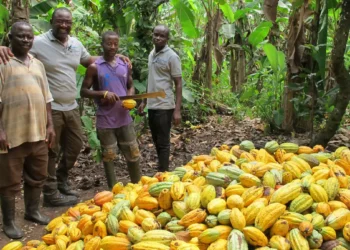The Ministry of Food and Agriculture (MoFA) is set to boost soya bean production to support the poultry industry in Ghana.
In Ghana, Soya bean is a non-staple crop and is predominantly used as livestock feed. Conventional poultry rations usually include many kinds of materials like soya bean, maize, rice, wheat, oat, fish-meal, meat-meal, groundnut-cake, amongst others according to their availability.
According to a research by MoFA, the increase in export of soya from Ghana has been tremendous, resulting in its shortage by use in the poultry industry. The Parliament of Ghana, to curb the shortages in Soya beans, passed a legislation in 2020 “Export and Import- restriction of soya bean regulation 2020 (L.I 2432)“.

“The competition for soya bean as an export product is creating a shortage of the commodity for use by the livestock, aquaculture, and poultry industry and has resulted in a price hike and its availability. This defeats the soya bean’s purpose for being promoted in the country. The high cost of feed in the poultry and aquaculture sectors is a major constraint to production. Feed costs are estimated to contribute over 60 percent of production costs in Ghana.
“With the anticipated increase in production in the coming seasons, surpluses realized can be exported through the proper process, to earn the country huge foreign exchange. In its effort to boost production, the government is currently subsidizing soya bean production and its availability for processing and use as animal feed by domestic livestock and poultry industry at a cheaper cost to boost local production in terms of the Rearing for Food and Jobs module (RFJ).”
MoFA
The market for Soya Bean in Ghana
For the increasing economic value of soya, there is a growing market for soya beans in Ghana, with an increase in domestic demand consistently exceeding domestic supply.
Ghana’s agriculture and aquaculture sectors are significant consumers of soya bean meal, a key ingredient in animal feed. The poultry industry alone demands about 75 percent of Ghana’s total soya bean annually.
Research has shown that consumers increasingly consume poultry products, meat, fish, and vegetable oils with increased awareness of healthy dieting habits. These factors are contributing to the indirect increase in demand for soya beans.
Soya production is gradually attaining commercial status as more producers are becoming aware of the availability of the market for the product. With the introduction of the PFJ in 2017, yields began rising to 1.7 and 1.8 mt/ha. Some experts have applauded this initiative by the government and affirm it will help offset the shortages in the poultry industry.
READ ALSO: Modified Version Of E-Levy May Generate More Revenues Than Expected – Economist






















